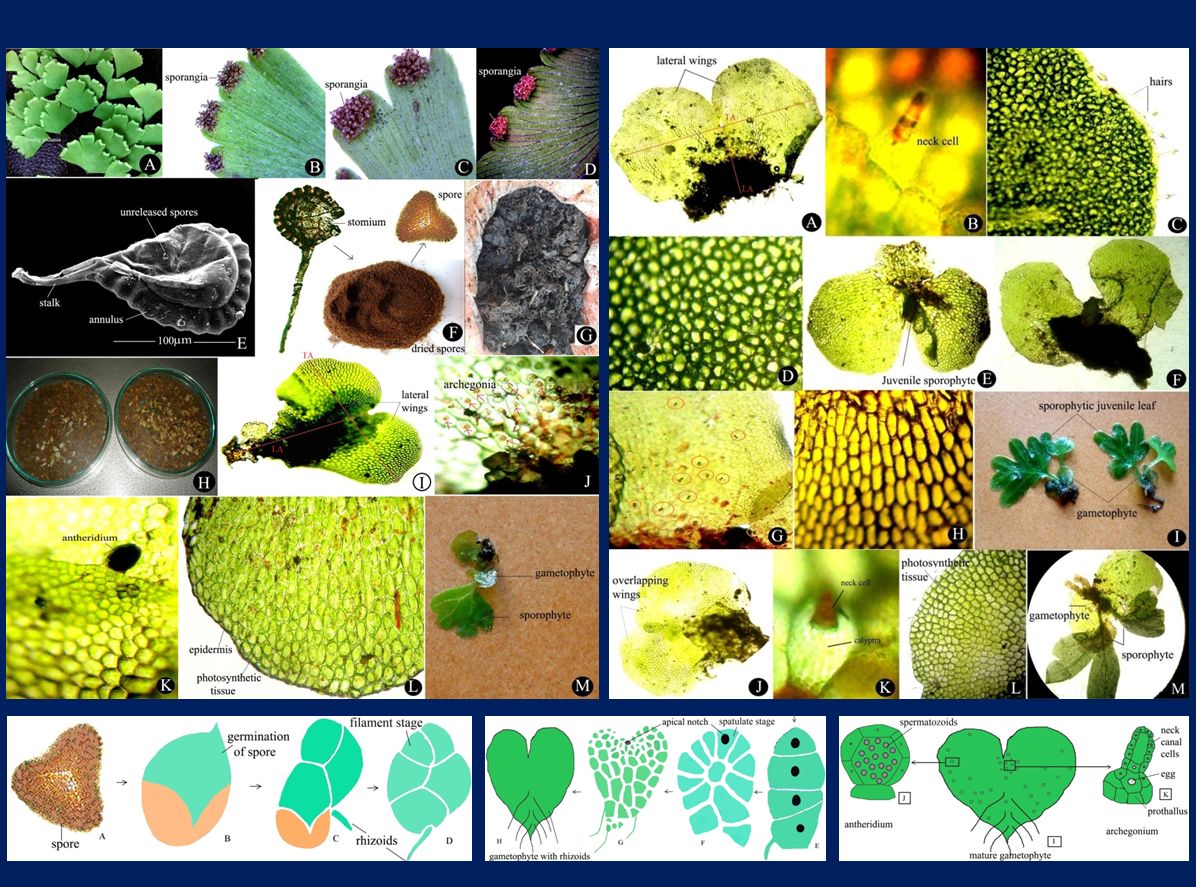Study on Gametophytes of Four Species of Maiden Hair Ferns (Adiantum L.) and Their Systematic Implications
DOI:
https://doi.org/10.15835/nsb11310471Keywords:
Adiantum; germination; morphology; prothallus; sporophytes; systematicsAbstract
Matured spores of four (4) species of maiden hair ferns namely, Adiantum capillus-veneris L., A. caudatum L., A. edgeworthii Hook. and A. incisum Forssk. were collected and grown in petri-dishes containing natural media formed by mixing dead wood of tree fern (Cyathea Sm.), sand and charcoal powder (2:1:1). The cultures in triplicates for each species were monitored every day from the stage of sowing to the chimera formation. After disintegration of gametophytes, juvenile sporophytes were shifted to pots and morphological characters were studied till the dehiscence of sporangia. Spore germination initiated between 4-6 days for A. capillus-veneris, 7-9 days in A. caudatum and A. incisum and 10-12 days in A. edgeworthii. Prothallia in all the Adiantum are autotrophic, Vittaria type, cordate-shaped, homosporous with antheridia developing earlier than archegonia and remain confined on the adaxial surface. The gametophytes showed considerable variation in their shapes, orientation of lobes, presence or absence of hairs and placement of sex organs on the prothallia. The gametophytic and sporophytic characters are correlated and used in structuring key to species. The study concludes that gametophytic characters also constitute a dependable criterion for assessing their systematics.
Metrics
References
Banks J (1999). Gametophyte development in ferns. Annual Review of Plant Physiology and Plant Molecular Biology 50(1):163-186.
Brahmachari G, Mondal S, Chatterjee D, Brahmachari K (2003). Phytochemicals and biological activities of Adiantum species. Journal of Science and Industrial Resources 62:1119-113.
Farrar DR (2003). Gametophyte morphology and breeding systems in ferns. In: Chandra S, Srivastava M (Eds). Pteridology in the New Millennium. Springer, Dordrecht.
Ganguly G, Mukhopadhyay R (2005). In vitro study on gametophyte development of Hypolepis alpine (Bl.) Hook. Phytomorpology 55(34):179-184.
Khoo S, Thomas M (1980). Studies on the germination of fern spores. The Plant Propagator 26(2):11-15.
Lu JM, Wen J, Lutz S, Wang YP, Li DZ (2012). Phylogenetic relationships of Chinese Adiantum based on five plastid markers. Journal of Plant Sciences 125(2):1-13.
Mithraja MJ, Antonisamy JM, Mahesh M (2012). Inter-specific variation studies on the phyto-constituents of Christella and Adiantum using phytochemical methods. Asia Pacific Journal of Tropical Biomedicine 2(1):S40-S45.
Nayar BK (1962). Studies in Pteridaceae. V. Contributions to the morphology of some species of maidenhair ferns. Botanical Journal of Linnaean Society 58(372):185-199.
Nayar BK, Kaur S (1971). Gametophytes of homosporous ferns. The Botanical Review 37(3):296-380.
Prado J, Rodrigues CN, Salatino A, Salatino ML (2007). Phylogenetic relationships among Pteridaceae, including Brazilian species, inferred from rbcL sequences. Taxon 56(2):355-368.
Raghavan V (1989). Developmental biology of fern gametophytes. Cambridge University Press, Cambridge, pp 361.
Stokey AG (1951). The contribution by the gametophyte to the classification of the homosporous ferns. Phytomorphology 1(1-2):39-58.
Stokey AG (1960). Multicellular and branched hairs on the fern gametophyte. American Fern Journal 50(1):78-87.

Downloads
Published
How to Cite
Issue
Section
License
Papers published in Notulae Scientia Biologicae are Open-Access, distributed under the terms and conditions of the Creative Commons Attribution License.
© Articles by the authors; licensee SMTCT, Cluj-Napoca, Romania. The journal allows the author(s) to hold the copyright/to retain publishing rights without restriction.
License:
Open Access Journal - the journal offers free, immediate, and unrestricted access to peer-reviewed research and scholarly work, due SMTCT supports to increase the visibility, accessibility and reputation of the researchers, regardless of geography and their budgets. Users are allowed to read, download, copy, distribute, print, search, or link to the full texts of the articles, or use them for any other lawful purpose, without asking prior permission from the publisher or the author.













.png)















